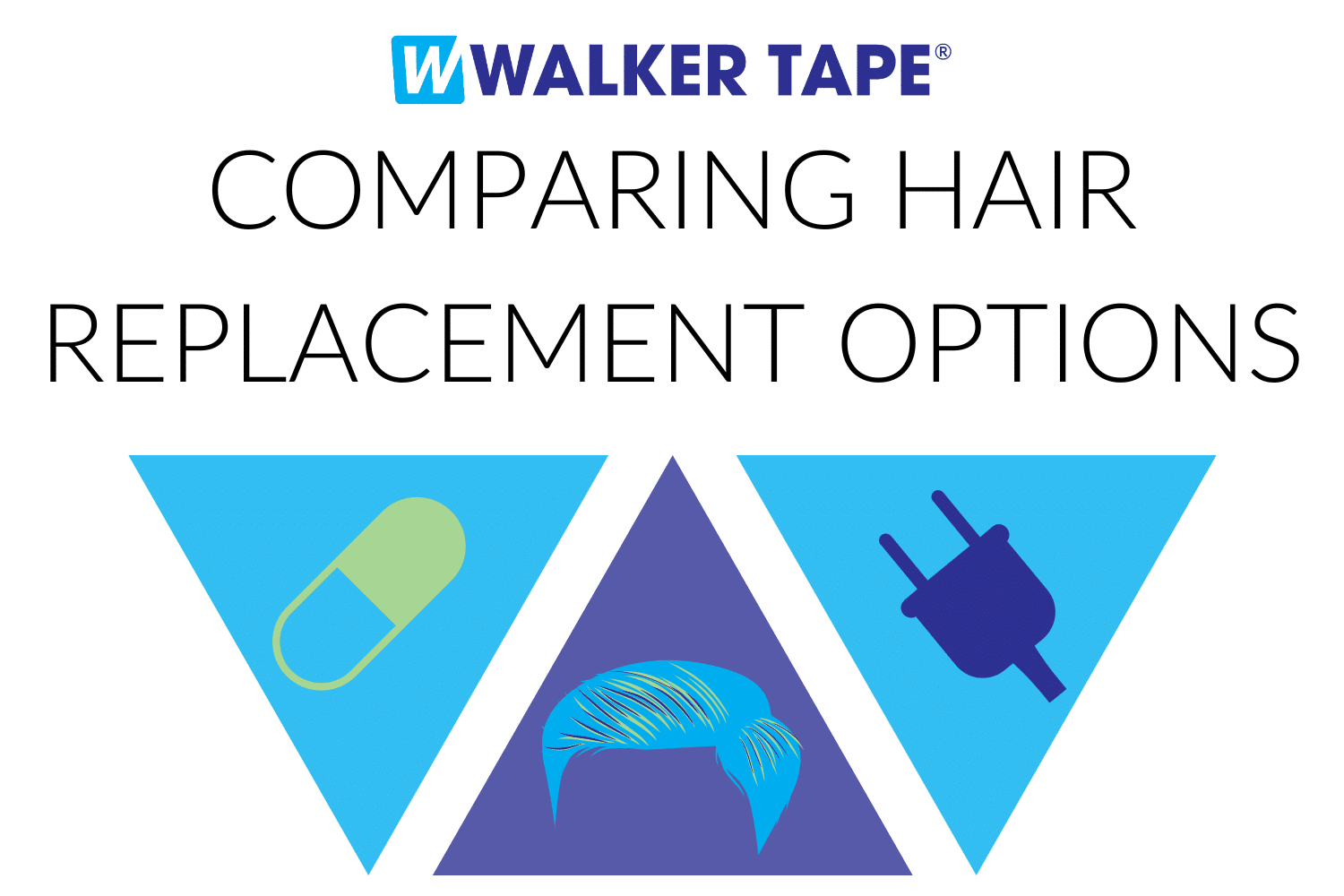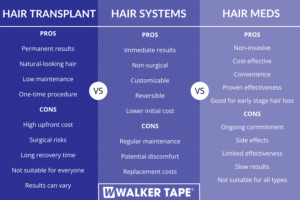
Comparing hair replacement options.
For those dealing with hair loss and entering the world of hair replacement, trying to find something that works for their specific situation can be tough. Maybe one option is too pricey. Another option involves risks and chemicals that they don’t want to risk. Essentially, trying to narrow it down can be stressful.
That’s why we’re going over three of the most common hair replacement options for clients. Starting with:
HAIR TRANSPLANTS
Possibly one of the more thought of – and chosen – choices for hair replacement are hair transplants.
A surgical option, a hair transplant takes hair follicles from one part of the body (the “donor” area) and transplants them to the balding or thinning s alp (the “recipient” area). There are two ways in which this can be done:
- Follicular Unit Transplantation: This option takes a strip of skin from an area, then divides the individual hair follicles and transplants them to the recipient area.
- Follicular Unit Extraction: This option extracts and takes individual hair follicles piece by piece and transplants them to the recipient area.
A hair transplant tends to take roughly 2-3 weeks to start healing. Then, the transplanted hair will begin to fall out, and new stimulated hair growth will begin within a few months. Full results can be seen about 6-12 months post-procedure.
- PROS
- Permanent Results: Offers a long-lasting solution for hair loss.
- Natural-Looking Hair: Uses the patient’s own hair for a natural appearance.
- Low Maintenance: Transplanted hair grows like regular hair once healed.
- One-Time Procedure: Usually requires only one or a few sessions.
- CONS
- High Upfront Cost: Can be expensive, often costing thousands of dollars.
- Surgical Risks: Includes risks such as infection, scarring, and complications.
- Long Recovery Time: Full healing can take weeks to months.
- Not Suitable for Everyone: Requires sufficient donor hair, limiting options for those with extensive hair loss.
- Results Can Vary: Depends on surgeon skill, type of hair loss, and healing process.
HAIR SYSTEMS
A non-surgical and non-prescription medication option for hair replacement are hair systems, commonly referred to as wigs or toupees by the general population.
Built for both partial and complete hair loss, hair systems are an ideal non-invasive choice for those dealing with hair loss. With multiple different attachment options available (adhesives, etc.), hair systems can be worn for as long as the wearer would like, and can be customized to fit the wearer.
- Pros
- Immediate Results: Provides instant coverage for hair loss.
- Non-Surgical: No need for invasive procedures.
- Customization: Offers a natural look tailored to color, density, and style.
- Reversible: Can be removed or changed without permanent effects.
- Lower Initial Cost: Less expensive upfront compared to surgical options.
- Cons
- Regular Maintenance: Requires ongoing cleaning, adhesive reapplication, and adjustments.
- Potential Discomfort: Can be uncomfortable in hot weather or during physical activities.
- Replacement Costs: Systems usually last 3-12 months, leading to recurring expenses.
HAIR LOSS MEDICATIONS
If both the hair transplant and the hair system options are declined, hair loss medications are another go-to option for those dealing with hair loss.
There are two primary types of hair loss medications:
- Topical Treatments: Topical treatments are applied to the scalp, or any hair loss area, to help stimulate hair growth. Some medications are anti-inflammatories that help suppress the immune system, while others irritate the skin to help create growth.
-
- Examples: Minoxidil, Corticosteroids, and Anthralin.
- Oral Medications: Oral medications for hair loss generally work by blocking dihydrotestosterone (DHT), the hormone linked to hair loss.
- Examples: Finasteride, Dutasteride, & Spironolactone.
Like systems and transplants, medications come with their own pros and cons
- PROS
- Non-Invasive: No surgery or procedures needed.
- Cost-Effective: Generally more affordable than surgical options.
- Convenience: Easy to use at home, like applying a topical solution or taking a pill.
- Proven Effectiveness: Clinically shown to slow hair loss and promote regrowth in some cases.
- Good for Early-Stage Hair Loss: Effective in maintaining existing hair if started early.
- CONS:
- Ongoing Commitment: Continuous use is needed to maintain results.
- Side Effects: Potential for side effects like decreased libido (finasteride) or scalp irritation (minoxidil).
- Limited Effectiveness: More effective at slowing hair loss than reversing it.
- Slow Results: Takes several months to see noticeable improvements.
- Not Suitable for All Types: Works best for androgenetic alopecia and may not help other hair loss conditions.

If you have any questions on hair systems and hair replacement, or comparing hair replacement options, please feel free to reach out to our Customer Service team at [email protected], or by phone at 1.800.759.5150. Be sure to follow our social medias to keep up with other awesome content.




